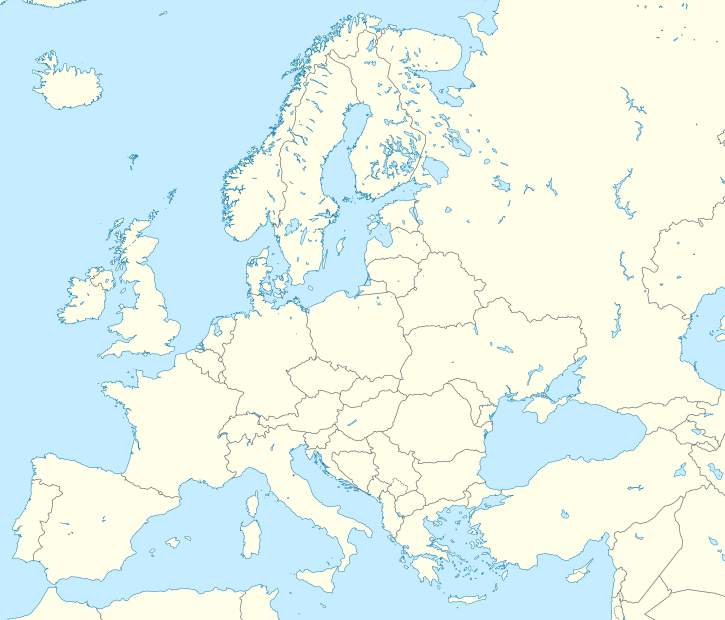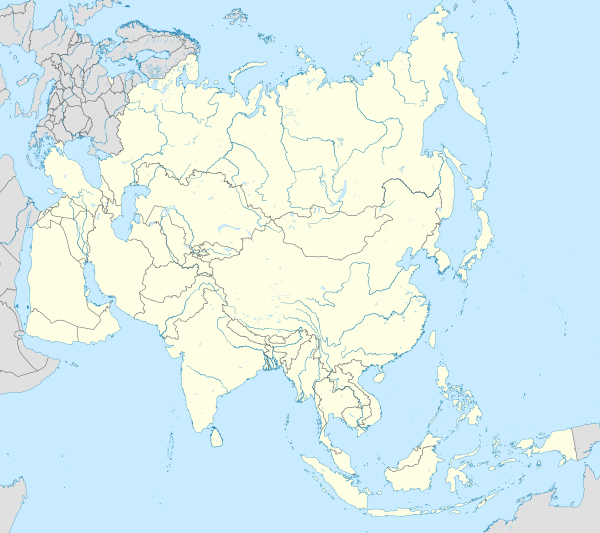Montréal–Trudeau International Airport
Montréal–Trudeau International Airport Aéroport International Montréal-Trudeau | |||||||||||||||
|---|---|---|---|---|---|---|---|---|---|---|---|---|---|---|---|
 | |||||||||||||||
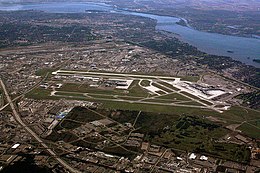 | |||||||||||||||
| Summary | |||||||||||||||
| Airport type | Public | ||||||||||||||
| Owner | Transport Canada | ||||||||||||||
| Operator | Aéroports de Montréal | ||||||||||||||
| Serves | Montreal | ||||||||||||||
| Location | Dorval, Quebec, Canada | ||||||||||||||
| Opened | September 1, 1941 | ||||||||||||||
| Hub for | |||||||||||||||
| Focus city for | Porter Airlines | ||||||||||||||
| Operating base for | |||||||||||||||
| Time zone | EST (UTC−05:00) | ||||||||||||||
| • Summer (DST) | EDT (UTC−04:00) | ||||||||||||||
| Elevation AMSL | 118 ft / 36 m | ||||||||||||||
| Coordinates | 45°28′14″N 073°44′27″W / 45.47056°N 73.74083°W | ||||||||||||||
| Public transit access | |||||||||||||||
| Website | www | ||||||||||||||
| Maps | |||||||||||||||
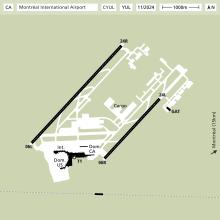 Airport Diagram | |||||||||||||||
 | |||||||||||||||
| Runways | |||||||||||||||
| |||||||||||||||
| Statistics (2024) | |||||||||||||||
| |||||||||||||||
Sources: Canada Flight Supplement[1] and Transport Canada[2] Environment Canada[3] Passenger traffic and movements from Aéroports de Montréal[4] | |||||||||||||||
Montréal–Trudeau International Airport (IATA: YUL, ICAO: CYUL) (French: Aéroport International Montréal-Trudeau) or Montréal–Trudeau, formerly known and still commonly referred to as Montréal–Dorval International Airport (Aéroport international Montréal-Dorval), is an international airport[5] in Dorval, Quebec, Canada. It is the only Transport Canada designated international airport serving Montreal and is situated 20 km (12 mi) west of Downtown Montreal. The airport terminals are located entirely in the suburb of Dorval, while one runway is located in the Montreal borough of Saint-Laurent. Air Canada, the country's flag carrier, also has its corporate headquarters complex on the Saint-Laurent side of the airport.[6][7] It also serves Greater Montreal and adjacent regions in Quebec and eastern Ontario, as well as the states of Vermont and northern New York in the United States.[8] The airport is named in honour of Pierre Elliott Trudeau, the 15th Prime Minister of Canada and father of current Prime Minister Justin Trudeau.
The airport is one of two managed and operated by Aéroports de Montréal (ADM), a not-for-profit corporation without share capital; the other is Montréal–Mirabel northwest of Montreal, which was initially intended to replace the one in Dorval but now deals almost solely with cargo and private flights.[9] Montréal–Trudeau is owned by Transport Canada which has a 60-year lease with Aéroports de Montréal, as per Canada's National Airport Policy of 1994.[2]
Trudeau is the busiest airport in the province of Quebec and the third-busiest airport in Canada by passenger traffic, with 22.4 million passengers in 2024.[4] It is one of eight Canadian airports with United States border preclearance and is one of the main gateways into Canada with 15.79 million or 71% of its passengers being on non-domestic flights, the highest proportion amongst Canada's airports.[10] YUL has also risen to become the 5th busiest transatlantic hub in North America.[11] The route between Montreal and Paris is Canada's busiest international route and the 6th busiest international route from North America, with more than 1.5 million passengers a year.[12][13] It is one of three Air Canada hubs and, in that capacity, serves mainly Quebec, the Atlantic Provinces and Eastern Ontario. On an average day, 58,000 passengers transit through Montréal-Trudeau.
Airlines servicing Trudeau offer year-round non-stop flights to five continents, namely Africa, Asia, Europe, North and South America.[14][15][16] It is one of only two airports in Canada with non-stop flights to five continents, the other being Toronto Pearson International Airport.[17] Trudeau airport is the headquarters of and a large hub for Air Canada, the country's largest airline. It is also the headquarters of Air Inuit and Air Transat, and an operation base for Sunwing Airlines and Porter Airlines. It also plays a role in general aviation as home to the headquarters of Innotech-Execair, Starlink, ACASS and Maintenance Repair & Overhaul (MRO) facilities of Air Transat and Air Inuit. Transport Canada operates a Civil Aviation Maintenance, Repair and Overhaul facility on site, with a fleet of Government owned and operated civil aircraft. Bombardier Aerospace has an assembly facility on site where they build Global and Challenger business jets.
History
[edit]Early years
[edit]By the 1940s, it was increasingly clear that Montreal's original airport, Saint-Hubert Airport, in operation since 1927, was no longer adequate for the city's needs. The Minister of Transport purchased land at the Dorval Race Track, which was considered the best location for an enlarged airport because of its good weather conditions and few foggy days. The airport opened on September 1, 1941, as Dorval Airport/Aéroport Dorval with three paved runways. By 1946 the airport was hosting more than a quarter of a million passengers a year, growing to more than a million in the mid-1950s. During World War II thousands of Allied aircraft passed through Dorval on the way to England. At one time Dorval was the major transatlantic hub for commercial aviation and the busiest airport in Canada, with flights from airlines such as British Overseas Airways Corporation (BOAC). Until 1959, it also doubled as RCAF Station Lachine.
Growth
[edit]
In November 1960, the airport was renamed Montreal–Dorval International Airport/Aéroport international Dorval de Montréal. On December 15 of that year the Minister of Transport inaugurated a new $30 million terminal. The structure was built by Illsley, Templeton, Archibald, and Larose.[18] At its height, it was the largest terminal in Canada and one of the biggest in the world. It was the gateway to Canada for all European air traffic and served more than two million passengers per year.[citation needed] Eight years later, Montréal–Dorval International Airport underwent a major expansion program. Despite this, the government of Prime Minister of Canada Pierre Elliott Trudeau (who represented a Montreal riding) predicted that Dorval would be completely saturated by 1985 and also projected that 20 million passengers would be passing through Montreal's airports annually. They decided to construct a new airport in Sainte-Scholastique, what became Montréal–Mirabel International Airport. As the first phase in the transition that would eventually have seen Dorval closed, all international flights (except those to and from the United States) were to be transferred to the new airport in 1975.[citation needed]
The opening and closing of Mirabel Airport
[edit]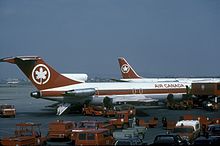
The Trudeau government had developed Mirabel Airport to handle an expected growth in international traffic and eventually, to replace Dorval.[citation needed] On November 29, 1975, Mirabel International Airport went into service. With an operations zone of 70 km2 (27 sq mi) and a buffer zone of 290 km2 (110 sq mi), it became the largest airport in the world. Many connecting flights to Canadian centres were transferred to Mirabel and 23 international airlines moved their overseas activities there.[citation needed] As a consequence, Montréal–Dorval was repurposed to serve domestic flights and transborder flights to the United States, to eventually shift these activities to Mirabel in the future and lead to Dorval's closure for redevelopment.[citation needed]
However, the extra traffic never materialized. Mirabel's traffic decreased due to the advent in the 1980s of longer-range jets that did not need to refuel in Montreal before crossing the Atlantic Ocean from the major Western North American cities. Montreal's economic decline in the late 1970s and 1980s also had a significant effect on both airports' traffic, which made Mirabel's additional capacity redundant. Although this redundancy would have been resolved if Dorval was decommissioned as originally intended, public pressure supported Dorval's continued operation due to its closer proximity to downtown Montreal at 20 km (12 mi) instead of 39 km (24 mi) for Mirabel. Another obstacle of the planned transfer from Dorval to Mirabel was Air Canada's desire to keep flights in Dorval with its proximity to AVEOS workshops.[19]
In particular, the simultaneous operation of Mirabel (international flights) and Dorval (continental flights) made Montreal less attractive to international airlines. Passengers who used Montreal in transit had to take long bus rides for connections from domestic to international flights (exacerbated by the partially-completed road links and non-existent rail connecting Mirabel to Montreal), unnecessarily complicating their journeys, while Montrealers grew to resent Mirabel as they were forced to travel far out of town for international flights. Faced with the stark economic reality of operating two Canadian points of entry, most international airlines opted to bypass Montreal altogether in favour of Toronto which enjoyed a single major airport at Pearson handling domestic and international flights. Although Dorval resumed handling international flights in 1997, international airlines were slow to return as they were content having established Toronto Pearson as their eastern Canadian gateway.[19]
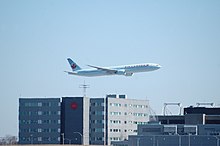
Back to Montréal–Dorval, renaissance
[edit]With all international scheduled flights returning to Montréal–Dorval in 1997, as well as charter flights in 2004, the consolidation of flights to Montréal–Dorval resulted in an increase in passenger traffic. Besides the transfer of flights, Montréal–Dorval International Airport could resume being a true hub for passengers in-transit, and those from continental flights would no longer have to travel to Mirabel to connect to international flights and vice versa. Nonetheless, this was insufficient to woo back international airlines who had already switched their eastern Canadian gateway to Toronto Pearson a decade ago.[19]
Starting as Dorval Airport, then Montréal–Dorval International Airport, the airport was renamed Montréal–Pierre Elliott Trudeau International Airport in Trudeau's honour on January 1, 2004, by the federal government. The renaming had been announced in September 2003 by then Minister of Transport David Collenette. This move provoked some opposition, especially Quebec sovereigntists opposed to Trudeau's staunchly federalist policies. The renaming also provoked opposition from many aviation historians and enthusiasts who recalled Trudeau's role in the effort to shutter Dorval in favour of the much larger and modern Mirabel Airport, of which he was the greatest instigator of its construction.[20] Many Montrealers still refer to Trudeau airport as "Dorval," or "Dorval Airport."[21]
Operation Yellow Ribbon
[edit]After the September 11 attacks, Dorval Airport participated in Operation Yellow Ribbon, taking in seven diverted flights that had been bound for the closed airspace over the United States, even though pilots were asked to avoid the airport as a security measure [citation needed]. Mirabel International Airport also took in 10 other diverted flights totaling 17 diverted flight in the Montreal area bound for American cities.[22]
75th anniversary
[edit]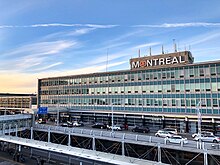
In 2016, Montréal-Trudeau celebrated its 75th anniversary. Under the theme Service, Destinations, Passion since 1941, various activities and contests were planned throughout the year. In partnership with the Canada Aviation and Space Museum, the airport hosted the Travelling Through Time exhibition in the public hall of the US Departures area.[23] Exhibits showcasing important milestones in the airport's history were incorporated throughout the terminal.
Expansion
[edit]Terminal expansion (2000–2007)
[edit]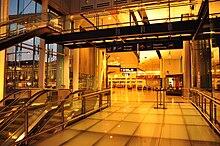
Montréal–Trudeau underwent a major expansion and modernization designed to increase the terminal's capacity and substantially enhance the level of passenger service. In February 2000, with a budget of CAD 716 million[citation needed], ADM announced plans for an extensive expansion plan that would bring Montréal–Trudeau up to standard with other North American airports its size. The airport terminal had for the most part remained the same, with the exception of minor renovations, since its opening in 1960. With increased passenger volume resulting from the transfer of international scheduled passengers from Mirabel Airport in 1997, as well as Air Canada's intentions to make Montréal–Trudeau its Eastern Canada hub, there was a strong need to greatly expand the terminal, whose capacity of roughly 7 million passengers per year had been exceeded.[citation needed]
The expansion program included the construction of several brand-new facilities, including a jetty for flights to the United States (US Preclearance Terminal), another for other international destinations (International Terminal) and a huge international arrivals complex. An 18-gate Transborder Concourse opened in 2003,[24] an 11-gate International Concourse opened in 2004,[24] new customs hall and baggage claim area for non-domestic flights and an expanded parking garage opened in 2005.[24] Additionally, sections of the domestic area were renovated and expanded in 2007, accompanied with additional retail space.[24] The International part of the Aeroquay satellite was demolished in 2008, leaving the domestic part for regional carriers.[24] The completion of the CAD 716 million expansion gives Montréal–Trudeau the ability to serve 15 million passengers a year.[25] This ironically accomplished one of the goals that was to be met with the construction of Mirabel. (In the 1970s, the federal government projected that 20 million passengers would be passing through Montreal's airports annually by 1985, with 17 million through Mirabel). Aéroports de Montréal financed all of these improvements itself, with no government grants. By the end of 2007, CAD 1.5 billion had been spent to upgrade Montréal–Trudeau.[26]
The last round of construction in this phase was to allow the airport to accommodate the Airbus A380. Gate 55, part of the international jetty, was designed for the requirements of the A380. It is equipped with two air bridges to load and unload passengers on both decks of the A380 simultaneously. With Phase II of the international jetty expansion now completed, the airport has two additional A380 gates, although there are currently no airlines operating this type of aircraft at the airport.
New hotel, transborder terminal expansion and modernization (2006–2009)
[edit]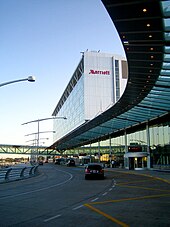
On June 15, 2006, construction began on a new four-star Marriott hotel at the airport, above the transborder terminal. Originally scheduled to be completed by September 2008, the 279 first-class room hotel opened its doors on August 19, 2009. Construction was slowed down because of the recession and a collapse in the Transborder market. It contains an underground train station that was planned to eventually connect the airport with downtown Montreal as well as ADM's corporate headquarters.
On the same day, Montreal–Trudeau airport opened the doors to the refurbished, expanded, modernized and user-friendly transborder terminal, meeting the industry's highest standards. This increased the total area of the terminal from 9,320 to 18,122 m2 (100,320 to 195,060 sq ft). Furthermore, the terminal is equipped with a new baggage sorting room which allows U.S. customs officers to retrieve luggage for secondary inspection.[26]
International terminal expansion (2011–2016)
[edit]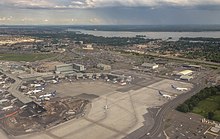
Air France became the first operator of the type in Montreal on April 22, 2011, when they officially launched their daily A380 service from Paris.[27] A380 service was reduced to 4 weekly flights during summer 2012 and withdrawn in October 2012, due to low demand for business class and a high level of competition, with Air Canada, Air Transat and Corsair also operating Montreal–Paris flights.[citation needed]
In July 2011, James Cherry, the CEO of Aéroports de Montréal, announced the construction of a two-phase expansion of Montréal–Trudeau's international terminal. The total cost of the project, now completed, has been around $620 million.[28][29]
Phase I of this project, which was completed on December 20, 2012, opened a new boarding lounge which can accommodate as many as 420 passengers, along with a new gate, numbered 62. It was officially completed at a cost of $270 million. The new gate can accommodate three Passenger Transfer Vehicles, allowing passengers to be transferred from the terminal to an aircraft parked on a remote stand nearby. When phase II of the expansion began in 2014, this gate was closed to passengers. It was reopened with the inauguration of the extension two years later.
Phase II of the project, which was officially inaugurated on May 10, 2016, and put into service two days after, added six new contact gates for wide-body jets, including two for the Airbus A380, increasing the total number of contact gates from 10 to 16. This expansion holds gates 63 through 68. The area has 20,000 m2 of open spaces, restaurants, shops and a children's playground area. It took two years to complete and opened four months ahead of the original schedule for a total cost of $350 million. It was conceived by Humà Design and integrates three massive art installations and four vitrines showcasing Montreal's museums. The extension of the international jetty was built to alleviate the high level of congestion on the tarmac and in the terminal.[30]
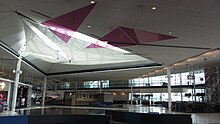
Apart from these expansions, ADM inaugurated in April 2016, a commercial area between gate 52 and 53. This area is called Haltes gourmandes (English: gourmet stops) referring to the large number of restaurants located there. The new restaurants are all owned by SSP Canada Food Service Inc. They operate 12 locations in the terminal, managing a total of 4000 m2 of terminal area. SSP invested over $200 million throughout 2016 in its airport locations.[31]
Future projects (2018–2030)
[edit]In January 2016, ADM published a call for tenders on their website regarding the restoration and upgrade of the curtain wall of the main façade on the terminal.[32] This part of the airport is one of the oldest remaining parts of the original terminal.
Also, according to the 2013–2033 master plan from ADM, the following future developments are in the works:
- Increase in the capacity of the passenger curb-side areas
- Development of a network of taxiways in the centre-west portion of the airport to support the development of a new air cargo handling area and an industrial development zone
- Reconfiguration of the international arrivals hall and of the domestic and international departures luggage room
- Extension of the transborder jetty and addition of a remote parking area[33]
On April 30, 2018, a massive new expansion project was unveiled that will last until 2030. The first phase ($2.5 billion) will see the airport's multi-level parking lot demolished and rebuilt with a green roof and the Montreal-Trudeau Airport REM station underneath. The drop-off area will be greatly expanded and covered with glass, and a new remote terminal will be built where runway 10/28 used to stand. By 2030, the remote terminal will be connected via future phases to the current terminal building to handle the expected growth. ADM CEO Philippe Rainville stated "the airport's growth has been about double the international average in recent years [so the] goal is to meet the growth projections of the airport."[34]
Infrastructure
[edit]Runways
[edit]There are currently two runways in operation at Montréal-Trudeau: two parallel runways aligned in a northeast–southwest direction (06L/24R and 06R/24L.) There was another single runway in an east–west direction (10/28), but it was permanently decommissioned in July 2023. The former runway is now a taxiway and will continue to be used as such.[35]
| Number | Length | Width | ILS | Alignment |
|---|---|---|---|---|
| 06L/24R[1] | 11,000 ft (3,400 m) | 200 ft (61 m) | Cat. II (6L), Cat. I (24R) | Northeast-southwest |
| 06R/24L[1] | 9,890 ft (3,010 m) | 200 ft (61 m) | Cat. I (both directions) | Northeast-southwest |
Terminal
[edit]This section needs additional citations for verification. (June 2016) |
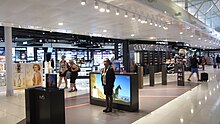
Montréal-Trudeau airport consists of one two-storied terminal, divided into four different zones: the public area (departures and arrivals level), the domestic jetty, the international jetty and the transborder jetty. There are two distinct areas in the public part of the airport (departure level); one is dedicated for the check-in of flights within or outside Canada (except U.S.) and the other one is for flights departing for the U.S. Both public areas are equipped with self-service check-in kiosks, a prayer area, shops and cafés. There is free Wi-Fi throughout the airport, luggage trolleys, ATMs and nursing rooms. When passengers arrive at Montréal-Trudeau from an international destination, they are welcomed into a huge and bright arrival complex, before passing through primary customs inspection, then go down one level to the baggage claim area and finally the international arrivals public area. The Aérogalerie program places artworks throughout the airport to showcase the city's artistic and cultural history. Works throughout the airport include showcases, illuminated columns, temporary exhibitions in the international arrival complex and permanent collection from various artists from the city.
The airport has eight mobile lounges that are used to shuttle passengers from the terminal to a plane parked at a remote hardstand spot.[36]
Domestic jetty
[edit]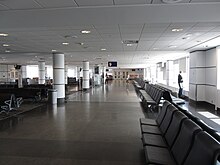
The domestic jetty, which is accessible via security checkpoint A, is divided into two parts: a satellite jetty connected by a tunnel to the main terminal and a wing attached to the main terminal building. The main jetty holds 16 gates: 1 through 12, 15, and 47 through 49. The satellite jetty holds another 10 gates: 17, 19, 21, 23, 25, 27, 28, 30, 32 and 34. There are only two boarding bridges located inside the satellite (17 and 21) as the other gates are mostly used for prop aircraft like the Bombardier Dash 8 family. These parts of the airport are the only departure areas remaining that were part of the original terminal.
International jetty
[edit]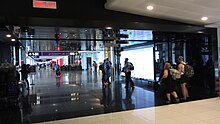
The International jetty, also accessible via the security checkpoint A, is dedicated to flights with destinations outside Canada and United States. This jetty holds 18 gates: 50 through 53 and 55 through 68. Gates 53 and 62 are used exclusively for Passenger Transfer Vehicles. In this area, travellers can shop, eat and relax with a wide varieties of boutiques, restaurants, cafés, spa facilities and one of the biggest airport duty-free shops in Canada. At the far end of the jetty, there is a wide open space with a lot of natural lights through floor to ceilings windows and a big skylight in the rooftop. The masterpiece of the jetty is a work of art, called Veil of Glass, composed of different coloured glass triangles illuminated by spotlights, created by local artist ATOMIC3. Several murals and other works of art are also located in this jetty, including four from various Montréal museums.[37]
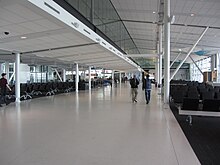
In the international jetty, there is a large area where passengers can relax before their flight. Travelers are able to download to their smartphone or e-reader the first chapter of any books available on the platform Lire vous transporte. After that, they can choose to buy the entire book through the Wi-Fi network in the airport. A rest area has been constructed near gate 57 in order to read these books in a calm environment, with cushions and dimmed lights.[38] There are over 1000 chairs with charging stations and USB ports throughout the jetty as well as three water bottle-filling stations.
Transborder jetty
[edit]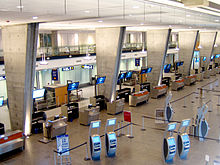
The transborder jetty is dedicated to all U.S. bound flights, and has 18 gates: 72 through 89. For access to gate 87, 88 or 89, passengers must go down one level via an escalator. Gate 56, 58 and 60 (part of the international jetty) can also be used for U.S. bound flights. They can be isolated from the other gates by moving glass walls known as swing gates. Unlike other jetties, the transborder jetty requires passengers to go through security checkpoint C and then the U.S. Customs and Border Protection and lastly through the duty-free shop before accessing their gates. The gate area contains the same services as the other parts of the airport such as shops, restaurants, rest zones and cafés. If needed, some gates can be isolated in order to offer additional security checkpoints if an aircraft flies to a potential risk zone like Washington–National.[citation needed]
Airport lounges
[edit]Two major airline alliances (SkyTeam and Star Alliance) are present at Montréal-Trudeau, and therefore both maintain frequent flyer lounges within the airport. There are also three "Pay-In" lounges open for use by all passengers, regardless of airline, frequent flyer status or class of travel.
- Air Canada Maple Leaf Lounge (Star Alliance)[39]
- Domestic - Gate 5
- International - Gate 52
- USA Transborder - Gate 73
- Air France KLM Lounge (SkyTeam)[40]
- International - Gate 57
- Desjardins Odyssey Lounge[41][42]
- International - Gate 63
- Desjardins Odyssey Lounge – Plaza Premium Lounge[43]
- USA Transborder - Gate 76
- National Bank Lounge[44]
- International - Gate 53
Airlines and destinations
[edit]Passenger
[edit]| Map of European passenger destinations |
|---|
| Map of Asian passenger destinations |
|---|
Statistics
[edit]Annual traffic
[edit]Graphs are unavailable due to technical issues. Updates on reimplementing the Graph extension, which will be known as the Chart extension, can be found on Phabricator and on MediaWiki.org. |
| Year | Passenger volume | % change | Domestic | % change | InternationalA | % change | TransborderA | % change |
|---|---|---|---|---|---|---|---|---|
| 2024[4] | 22,400,099 | 6,603,647 | 10,595,413 | 5,201,039 | ||||
| 2023[120] | 21,173,941 | 6,593,705 | 9,847,904 | 4,732,332 | ||||
| 2022[120] | 15,980,670 | 5,412,293 | 7,100,615 | 3,467,762 | ||||
| 2021B[121] | 5,201,751 | 2,442,801 | 1,903,257 | 855,693 | ||||
| 2020B[122] | 5,437,210 | 2,009,014 | 2,386,734 | 1,041,462 | ||||
| 2019[123] | 20,305,106 | 7,192,116 | 8,595,100 | 4,517,890 | ||||
| 2018[124] | 19,428,143 | 7,145,771 | 7,866,203 | 4,416,169 | ||||
| 2017[125] | 18,160,223 | 6,916,725 | 7,135,975 | 4,107,523 | ||||
| 2016[125] | 16,589,067 | 6,431,691 | 6,288,860 | 3,868,516 | ||||
| 2015[125] | 15,517,382 | 5,874,944 | 5,933,290 | 3,709,148 | ||||
| 2014[125] | 14,840,067 | 5,705,140 | 5,561,286 | 3,573,641 | ||||
| 2013[126] | 14,095,272 | 5,408,528 | 5,302,692 | 3,384,052 | ||||
| 2012[127] | 13,809,820 | 5,333,749 | 5,244,656 | 3,231,415 | ||||
| 2011[10] | 13,668,829 | 5,225,786 | 5,239,928 | 3,203,115 | ||||
| 2010[10] | 12,971,339 | 4,957,003 | 4,864,921 | 3,149,415 | ||||
| 2009[128] | 12,224,534 | 4,793,177 | 4,567,686 | 2,863,671 | ||||
| 2008[128] | 12,813,320 | 5,278,945 | 4,465,589 | 3,068,786 | ||||
| 2007[128] | 12,817,969 | 5,393,576 | 4,245,642 | 3,178,751 | ||||
| 2006[129] | 11,441,202 | 4,653,599 | 3,708,264 | 3,079,339 |
^A : At Montréal–Trudeau and at other airports in Canada with United States border preclearance, a distinction is made between "transborder" and "international" flights for operational and statistical purposes. A "transborder" flight is a flight between Canada and a destination in the United States, while an "international" flight is a flight between Canada and a destination that is not within the United States or Canada. A "domestic" flight is a flight within Canada only.
^B : During 2020 & 2021, there was a significant decrease of passenger numbers due to the COVID-19 global pandemic and Canada border closures and/or restrictions.
Ground transportation
[edit]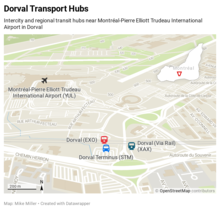
Public transit
[edit]Montréal–Trudeau is accessible by six bus routes operated by the Société de transport de Montréal (STM): one dedicated airport transfer service, one express route, two regular daytime routes, and two night buses.
Introduced on March 29, 2010, the 747 Montreal-Trudeau/Downtown route operates for 24 hours every day of the year, connecting the airport to Lionel-Groulx metro station, Central Station, Berri-UQAM metro station, and the city center.[130][131] Prior to the introduction of the 747 bus service, Groupe La Québécoise operated a coach service known as L'Aerobus between the airport and Central Station, connecting with several hotels downtown.[132][133]
In addition to the 747, Montréal–Trudeau is accessible by the 204 Cardinal and 209 Des Sources everyday, while the 356 Lachine/YUL Aéroport/Des Sources and 378 Sauvé/YUL Aéroport serve the airport during night service hours. It is also accessible by the 460 Express Métropolitaine, which runs during rush hours. These routes provide service to the Dorval bus terminus and train station, which is within walking distance of Via's Dorval station.[134]
| Société de transport de Montréal | |
|---|---|
| Route | Destination |
| |
| |
| |
| |
| |
| |
Intercity rail connections
[edit]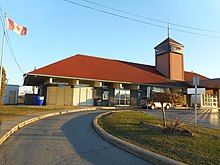
Connection to Via Rail, the national train operator in Canada, is possible through an airport shuttle bus to Dorval station (IATA: XAX) located 2 kilometres (1.2 mi) to the south of the airport.[135] It is the nearest station on the Québec City-Windsor Corridor and offers inter-city rail connections to Quebec City, Ottawa, Kingston and Toronto as well as smaller regional centres in Quebec and Ontario. Via does not provide local service between Dorval and Montreal Central Station.
The shuttle bus from Montréal–Trudeau International Airport to Dorval station is free of charge to Via Rail passengers. Operated by indigo, the service departs from departures door 8 every 45-60 minutes during the stations opening hours, taking around 5 minutes to reach its destination.[135]
Intercity bus
[edit]KLM Royal Dutch Airlines operates a bus from Trudeau Airport to Ottawa Railway Station only for Air France-KLM customers originating in/arriving in the Ottawa area.[136] As of 2016[update] Air-France KLM has three daily bus services between those cities.[137]
Air France also operates a bus from Trudeau to Sainte-Foy in Quebec City for its customers.[137]
Swiss International Air Lines previously operated its Swissbus service from Trudeau to Ottawa Railway Station for Swiss customers.[138]
Orléans Express offers service from Ottawa, Gatineau, Drummondville, and Quebec City.[139]
Car
[edit]The airport is accessible from Highway 20 or from Highway 520, a spur off Highway 40 that leads directly towards the airport. Eastbound Highway 20 leads to the Dorval interchange, the exit which drivers must take for the airport. From the north, Côte-Vertu Boulevard that runs parallel to runways 24L and 24R provides access to the Air Canada Base and hangars, Air Transat hangars, Air Inuit hangars, Bombardier Aerospace assembly facility and the deicing facility.
When drivers pick up or drop off guests at Trudeau, they are permitted to stop momentarily outside the Arrivals and Departure areas at both the Canada and International departures as well as the Transborder Jetty.
Aéroports de Montréal, the City of Montreal, Transports Québec and Transport Canada made plans to improve the Dorval interchange and built direct road links between the airport and highways 20 and 520. Once the certificate of authorization was obtained, work began in June 2009 with an original projected end date of 2017, although some parts of the project will be on hold for several years. The project entails redesigning the road network within the airport site, which was mostly completed as planned.[140]
Future connections
[edit]On April 22, 2016, the CEO of the Caisse de Dépot et de Placement du Québec Michael Sabia and Montreal mayor Denis Coderre announced a massive transit project called Réseau express métropolitain, slated to open between 2023 and 2027. This planned rapid transit network will connect the Trudeau Airport to the Central station in Downtown Montréal, the North Shore, the South Shore and the West Island. It will run from 5am to 1am, 7 days a week. Construction began in April 2018 and will connect Trudeau Airport with downtown by 2027.[141]
Incidents and accidents
[edit]- November 29, 1963 – Trans-Canada Air Lines Flight 831 crashed shortly after departure for Toronto International Airport, killing all 118 people on board the Douglas DC-8 jet.[142]
- On June 18, 1998, Propair Flight 420 suffered from brake dragging on departure from Trudeau Airport (then known as Montreal Dorval Airport). This heated up the wheel brakes of the Fairchild Metroliner, which eventually became lit by hydraulic fluid, starting a fire in the left wing. The aircraft attempted to divert to Mirabel International Airport. However, the left wing suffered a structural failure due to the extreme flames, and the aircraft rolled and hit the ground upside down, killing all 11 people on the flight.
- June 5, 2015 – WestJet flight 588 from Toronto Pearson International Airport, operated by a Boeing 737-600 (Registration C GWCT) slid off the runway while landing. There were no fatalities or injuries among the passengers and crew.[143]
- July 9, 2023 – Air Canada Flight 885, a B777-300ER from Geneva International Airport (Registration C-FITL) was standing at the gate when a water truck caught fire under the tail section. As passengers began disembarking, the water service truck located near the rear cargo door caught fire. The flames reached the aircraft's skin and smoke was detected in the cabin. A rapid deboarding was ordered, and all passengers exited to the terminal while the fire was brought under control by emergency services. No injuries were reported.[144]
Tenants
[edit]Jet Fuel A, A-1 and 100DLL are available from various FBOs at Dorval.[145]
References
[edit]- ^ a b c Canada Flight Supplement. Effective 0901Z 16 July 2020 to 0901Z 10 September 2020.
- ^ a b "Airport Divestiture Status Report". Tc.gc.ca. January 12, 2011. Archived from the original on February 23, 2007. Retrieved February 19, 2011.
- ^ Synoptic/Metstat Station Information. climate.weatheroffice.gc.ca
- ^ a b c "2024 Aéroports de Montréal Passenger Statistics". admtl.com. January 23, 2024.
- ^ Canada, Transport (August 22, 2023). "Advisory Circular (AC) No. 302-032". 00000000 00000000.
- ^ "Detailed Map of Dorval Archived February 17, 2012, at the Wayback Machine." City of Dorval. Retrieved November 4, 2010.
- ^ "ab11e5b4-ccb1-430e-9a7c-598d63c7480b.gif Archived July 6, 2011, at the Wayback Machine." City of Montreal. Retrieved December 4, 2010.
- ^ Montréal-Trudeau at a glance. Aéroports de Montréal
- ^ "Hélibellule fleet". Helibellule.ca. Archived from the original on January 2, 2012. Retrieved February 1, 2012.
- ^ a b c "Aéroports de Montréal Passenger Statistics" (PDF). Retrieved June 28, 2012. [permanent dead link]
- ^ media, LogiMonde. "Air Canada celebrates 5 new routes from Montreal… and much more!". www.paxnews.com.
- ^ https://www.oag.com/busiest-routes-world-2024
- ^ https://docs.google.com/spreadsheets/d/1XDk8Eg3D9Z66x1mWsZM7fz9MM8Co6umVQzYWRxwIHf4/edit?gid=467612056#gid=467612056
- ^ "International destinations: Direct flights – Aéroports de Montréal". ADM. Archived from the original on June 18, 2015. Retrieved June 6, 2015.
- ^ "U.S. destinations: Direct flights – Aéroports de Montréal". ADM. Archived from the original on June 22, 2015. Retrieved June 6, 2015.
- ^ "Canadian destinations: Direct flights – Aéroports de Montréal". ADM. Archived from the original on June 18, 2015. Retrieved June 6, 2015.
- ^ "Toronto Pearson Airport Route Map" (PDF). Greater Toronto Airports Authority. August 18, 2014. Archived from the original (PDF) on June 3, 2013. Retrieved August 18, 2014.
- ^ Kalman, Harold D. (March 4, 2015). "Airport Architecture". The Canadian Encyclopedia (online ed.). Historica Canada.
- ^ a b c Archived at Ghostarchive and the Wayback Machine: Radio-Canada Info (May 1, 2014). "Mirabel : autopsie d'un échec". Retrieved September 11, 2017 – via YouTube.
- ^ "Trudeau Airport named despite protests". CBC News. September 9, 2003. Archived from the original on February 11, 2009. Retrieved March 1, 2008.
- ^ "Travel to Montreal". McGill University. Archived from the original on July 3, 2014. Retrieved July 29, 2014.
- ^ "NAV CANADA and the 9/11 Crisis". Navcanada.ca. September 11, 2001. Archived from the original on April 18, 2012. Retrieved February 19, 2011.
- ^ "Exhibition on Montreal-Trudeau's History". Aeroports de Montreal. Archived from the original on August 8, 2016.
- ^ a b c d e "Montréal Trudeau: 70 Years of Success" (PDF). Aéroports de Montréal. p. 8. Archived (PDF) from the original on October 17, 2015. Retrieved June 3, 2015.
- ^ "Montreal–Trudeau International Airport at your service – p. 18" (PDF).
- ^ a b "New Sector for departures to the United States" (PDF).
- ^ "Air France – Corporate : Code-share agreement between Air France and Vietnam Airlines". Corporate.airfrance.com. April 2, 2010. Archived from the original on November 23, 2010. Retrieved February 19, 2011.
- ^ "Rapid international traffic growth at Montreal airport prompts terminal expansion". Archived from the original on June 18, 2018. Retrieved July 19, 2011.
- ^ "Montreal-Trudeau airport is expanding: Opening of new boarding lounges" (PDF). Retrieved December 8, 2012. [permanent dead link]
- ^ "Expanded Trudeau airport wing to offer 'a sense of the city'". Montreal Gazette. Archived from the original on May 11, 2016. Retrieved May 11, 2016.
- ^ "SP Canada Awarded $200 Million Contract at Montréal-Trudeau International Airport". SSP Canada. Archived from the original on June 26, 2016. Retrieved May 11, 2016.
- ^ "Request for tender" (PDF). Aéroports de Montréal. Archived (PDF) from the original on April 11, 2016. Retrieved March 29, 2016.
- ^ "2013-2033 Master plan" (PDF). Aéroports de Montréal. Archived (PDF) from the original on April 11, 2016. Retrieved March 29, 2016.
- ^ "Montreal's Trudeau airport to get $2.5-billion facelift". Archived from the original on January 25, 2019. Retrieved January 27, 2019.
- ^ "YUL Montréal-Trudeau International Airport - Permanent Modification of Runway 10-28 to a Taxiway". Canada.ca. Government of Canada - Impact Assessment Agency of Canada. May 25, 2023. Retrieved October 18, 2023.
- ^ Vanderbilt, Tom (September 3, 2024). "Postcard from Washington: the surprising renaissance of the 'mobile lounge'". Financial Times. Retrieved January 14, 2025.
- ^ "Aéroports de Montréal inaugurates $350 million worth of expansions and improvements" (PDF). ADM. Archived (PDF) from the original on June 4, 2016. Retrieved May 11, 2016.
- ^ "Free services". ADM. Archived from the original on May 20, 2016. Retrieved May 11, 2016.
- ^ "Maple Leaf Lounge locations". Air Canada. 2013. Archived from the original on October 10, 2013. Retrieved September 30, 2013.
- ^ "Air France KLM Lounge". Aéroports de Montréal. Archived from the original on January 16, 2017. Retrieved January 13, 2017.
- ^ "Desjardins Odyssey Lounge". Aéroports de Montréal. Archived from the original on January 16, 2017. Retrieved January 13, 2017.
- ^ "Leaving on your trip". Desjardins. Archived from the original on December 20, 2016. Retrieved December 6, 2016.
- ^ "Salon Odyssée Desjardins – Plaza Premium Lounge". Retrieved May 5, 2024.
- ^ "National Bank Lounge". Aéroports de Montréal. Archived from the original on December 18, 2018. Retrieved December 18, 2018.
- ^ "Your safety is our top priority". Aeroméxico. June 2021. Retrieved June 7, 2021.
- ^ "Our Destinations". Air Algérie. Archived from the original on November 15, 2017. Retrieved November 15, 2017.
- ^ "AIR CANADA NW23 TRANSBORDER OPERATION CHANGES – 29MAY23".
- ^ https://www.aeroroutes.com/eng/250107-acns25220us
- ^ "Air Canada NS24 US Service Changes – 21SEP23". Aeroroutes. Retrieved September 22, 2023.
- ^ "Air Canada adds A330 Montreal-Las Vegas service in NW24". Aeroroutes. Retrieved July 5, 2024.
- ^ "Air Canada NS25 Montreal – Europe Network Additions". Aeroroutes. Retrieved August 28, 2024.
- ^ https://www.aeroroutes.com/eng/250107-acns25220us
- ^ "Air Canada vai voar entre Porto e Montreal no próximo Verão". August 27, 2024.
- ^ "Air Canada NS24 Intercontinental Network Changes – 25FEB24".
- ^ "Air Canada Adds Montreal – Seoul Service From June 2024". Aeroroutes. Retrieved March 7, 2024.
- ^ "Air Canada NW24 Sun Destinations Service Changes – 26JUN24". Aeroroutes. Retrieved June 27, 2024.
- ^ "Travel to or from Israel". www.aircanada.com. Air Canada. Retrieved July 14, 2024.
- ^ "Air Canada NS25 A220 Domestic Network Additions". Aeroroutes. Retrieved January 18, 2025.
- ^ a b c "Flight Schedules". Air Canada. Archived from the original on March 23, 2018. Retrieved October 6, 2019.
- ^ "Air Canada launches flight from Montréal to Cincinnati". X. IshrionAviation.
- ^ "AIR CANADA NS24 US OPERATION CHANGES – 25FEB24". Aeroroutes. February 26, 2024.
- ^ "Air Canada Expands its Sun Network with 55 Caribbean and US Destinations this Winter". newswire. June 26, 2024. Retrieved June 26, 2024.
- ^ "Air Canada adds Tulum & Charleston flights, boosts capacity in key markets". Pax News. December 14, 2023. Retrieved December 14, 2023.
- ^ "Flight schedule". Air Creebec. Archived from the original on April 19, 2019. Retrieved October 6, 2019.
- ^ "Winter 2022: Air France increases frequencies to Lapland and renews its Pointe-à-Pitre – Montreal route | Air France - Corporate".
- ^ "Air France flight schedule". Air France. Archived from the original on November 16, 2017. Retrieved November 15, 2017.
- ^ "Flight schedules". Air Inuit. Archived from the original on November 15, 2017. Retrieved November 15, 2017.
- ^ "Flight schedules Montreal". Air Saint-Pierre. Archived from the original on November 15, 2017. Retrieved November 15, 2017.
- ^ "Air Transat Schedules Peru Launch in Dec 2023". Aeroroutes. Retrieved August 11, 2023.
- ^ "Air Transat Schedules Marrakech Launch in June 2024". Aeroroutes. Retrieved October 26, 2023.
- ^ "Air Transat Plans Tulum Service in late-Dec 2024". Aeroroutes. Retrieved July 9, 2024.
- ^ "Air Transat Unveils its Summer 2025 Flight Program". Newswire. Retrieved November 28, 2024.
- ^ "Air Transat Flight status and schedules". Flight Times. Air Transat. Archived from the original on March 22, 2018. Retrieved November 15, 2017.
- ^ a b "Flight schedules and notifications". American Airlines. Archived from the original on February 2, 2017. Retrieved November 15, 2017.
- ^ "Arajet Launches Punta Cana Service From late-Oct 2024". Aeroroutes. Retrieved July 20, 2024.
- ^ "Arajet Schedules Montreal Nov 2023 Launch". Aeroroutes. Retrieved July 26, 2023.
- ^ "Destinations". Arajet.
- ^ "Austrian Timetable". Austrian Airlines. Archived from the original on March 31, 2019. Retrieved April 29, 2019.
- ^ "Colombia and Canada closer: Avianca launches sales of new Bogotá-Montreal route and adds a new destination". Travel2latam. January 10, 2024.
- ^ "Avianca anuncia la nueva ruta directa San Salvador - Montreal". March 22, 2024.
- ^ "Schedules". Azores Airlines. Archived from the original on November 9, 2017. Retrieved November 15, 2017.
- ^ "Azores Airlines Expands Ponta Delgada NW24 Network". aeroroutes.com. August 1, 2024. Retrieved August 1, 2024.
- ^ "Timetables". British Airways. Archived from the original on March 30, 2017. Retrieved November 15, 2017.
- ^ "Flight Schedule".
- ^ "Flight Schedule". Copa Airlines. Archived from the original on November 9, 2017. Retrieved November 15, 2017.
- ^ a b "Flight Schedules". Delta Air Lines. Archived from the original on June 21, 2015. Retrieved November 15, 2017.
- ^ "Emirates to expand global network with launch of services to Montréal in July" (Press release). emirates.com. April 24, 2023.
- ^ "Flair Airlines NW23 Network Expansion – 01AUG23". Aeroroutes. Retrieved August 2, 2023.
- ^ "Flair Airlines Adds Montreal – Florida Service in NW23". Aeroroutes. Retrieved May 10, 2023.
- ^ "Where we fly". Flair Airlines. Retrieved March 30, 2021.
- ^ "Flair Airlines Brings Low Fares to Montreal". The Gazette. Retrieved March 30, 2021.
- ^ Liu, Jim (November 3, 2024). "French Bee NW25 Montreal Preliminary Operations – 03Nov24". AeroRoutes. Retrieved December 31, 2024.
- ^ "Our destinations". French Bee. Retrieved October 17, 2024.
- ^ "View the Timetable". KLM. Archived from the original on September 12, 2017. Retrieved November 15, 2017.
- ^ "Lufthansa Timetables".
- ^ Liu, Jim. "OWG revises service launch to mid-Dec 2020". Routesonline. Retrieved October 26, 2020.
- ^ "Where we Fly". Provincial Airlines. Archived from the original on November 15, 2017. Retrieved November 15, 2017.
- ^ a b "Porter More Than Doubles Capacity to Five Florida Destinations This Winter, Adds West Palm Beach Service". Business Wire. June 26, 2024.
- ^ "Porter Airlines Expands Las Vegas Service With New Service to Ottawa and Montréal". Business Wire. July 30, 2024.
- ^ a b "Porter connects Montréal to sunny California with two non-stop routes". Porter Airlines Inc. Retrieved March 12, 2024.
- ^ "Route". Porter. Archived from the original on November 15, 2017. Retrieved November 15, 2017.
- ^ "View the Timetable". Qatar Airways. Archived from the original on October 4, 2017. Retrieved November 15, 2017.
- ^ "Route map". Royal Air Maroc. Archived from the original on November 15, 2017. Retrieved November 15, 2017.
- ^ "Route map". Royal Jordanian. Archived from the original on November 15, 2017. Retrieved November 15, 2017.
- ^ "SUN COUNTRY NS24 CANADA NETWORK EXPANSION". AeroRoutes. October 18, 2023. Retrieved October 18, 2023.
- ^ a b "Sunwing Airlines NW24 Network Additions". Aeroroutes. Retrieved September 17, 2024.
- ^ "Sunwing announces its 2024-2025 winter schedule with the addition of three new sun destinations Canadians can explore, including Tulum, Camaguey-Santa Lucia and San Andrés". Cision. August 20, 2024. Retrieved August 22, 2024.
- ^ "Sunwing Airlines anunció vuelos entre Montreal y San Andrés". www.xn--elisleo-9za.com. Retrieved September 8, 2024.
- ^ "Route network". SWISS. Archived from the original on November 15, 2017. Retrieved November 15, 2017.
- ^ "Swiss NS23 Intercontinental Network Adjustement – 20OCT22". Timetable Updates. aeroroutes.com. Retrieved October 25, 2022.
- ^ "All Destinations". TAP Portugal. Archived from the original on May 12, 2017. Retrieved November 25, 2019.
- ^ "TAP Air Portugal June – August 2020 operations as of 31MAY20".
- ^ "Route map". Tunisair. Archived from the original on November 15, 2017. Retrieved November 15, 2017.
- ^ "Online Flight Schedule". Turkish Airlines. Archived from the original on April 10, 2019. Retrieved April 8, 2019.
- ^ "United Airlines Launching New Flights from San Francisco to Montreal". aviationa2z.com. April 27, 2024. Retrieved April 28, 2024.
- ^ "United Flight Schedules". United Airlines. Retrieved January 19, 2024.
- ^ "Adventure Awaits: United Unveils New Summer Flights to Top Outdoor North American Destinations". united.com. Retrieved January 26, 2024.
- ^ "United Flight Schedules". United Airlines. Archived from the original on January 28, 2017. Retrieved November 15, 2017.
- ^ "Flight Schedules - when we fly". Westjet. Archived from the original on February 10, 2017. Retrieved November 15, 2017.
- ^ a b "2023 Aéroports de Montréal Passenger Statistics" (PDF). admtl.com. March 22, 2024.
- ^ "2021 Aéroports de Montréal Passenger Statistics" (PDF). admtl.com. February 23, 2022.
- ^ "2020 Aéroports de Montréal Passenger Statistics" (PDF). admtl.com. April 1, 2021.
- ^ "2019 Passenger Traffic and Aircraft Movements" (PDF). Aeroports de Montreal. Retrieved February 17, 2020.
- ^ 2018 Aéroports de Montréal Passenger Statistics Archived April 25, 2018, at the Wayback Machine. (PDF) Retrieved June 22, 2018.
- ^ a b c d 2014-2017 Aéroports de Montréal Passenger Statistics Archived February 19, 2018, at the Wayback Machine. (PDF) Retrieved February 10, 2018.
- ^ "2013 Aéroports de Montréal Passenger Statistics" (PDF).
- ^ "2012 Aéroports de Montréal Passenger Statistics" (PDF).
- ^ a b c "2007–2010 Aéroports de Montréal Passenger Statistics" (PDF).
- ^ "2006–2009 Aéroports de Montréal Passenger Statistics" (PDF). Archived from the original (PDF) on March 26, 2010.
- ^ "Press releases". STM. June 10, 2010. Archived from the original on January 27, 2011. Retrieved February 19, 2011.
- ^ "747 YUL Montreal-Trudeau Airport: routes, schedule and fare purchase". STM. 2024. Retrieved July 22, 2024.
- ^ "Navette et autobus métropolitains". www.admtl.com. Archived from the original on July 6, 2010.
- ^ "Groupe La Québécoise, Airport Transportation". Autobus.qc.ca. Archived from the original on June 16, 2008. Retrieved February 19, 2011.
- ^ "209 Des Sources direction NORD". STM. 2024. Retrieved July 22, 2024.
- ^ a b "Dorval train station". Retrieved July 20, 2024.
- ^ "Travel by bus or rail with a KLM ticket Archived October 29, 2016, at the Wayback Machine." KLM. Retrieved October 29, 2016.
- ^ a b "A new bus service to Quebec City Archived February 20, 2017, at the Wayback Machine." Air France. August 16, 2016. Retrieved October 29, 2016.
- ^ "Swissbus Bus transportation between Ottawa and Montreal-Trudeau airport" (). Swiss International Air Lines. June 20, 2012. Retrieved October 29, 2016.
- ^ "horaires-aoe-imprime-EN_2-juillet-2024_rev2.pdf" (PDF). Orléans Express. July 2, 2024. Retrieved August 17, 2024.
- ^ "reamenagement echangeur". Archived from the original on December 28, 2017. Retrieved December 27, 2017. (in French)
- ^ "electric train project". Archived from the original on January 26, 2019. Retrieved January 27, 2019.
- ^ Ranter, Harro. "ASN Aircraft accident Douglas DC-8-54F CF-TJN Ste-Thérèse-de-Blainville, QC". aviation-safety.net. Archived from the original on October 20, 2013. Retrieved September 11, 2017.
- ^ WestJet plane from Toronto slides off runway in Montreal, no injuries reported Archived June 13, 2015, at the Wayback Machine. Ctvnews.ca (June 5, 2015). Retrieved November 7, 2015.
- ^ "Serious incident Boeing 777-333(ER) C-FITL, 09 Jul 2023". aviation-safety.net. Retrieved July 26, 2023.
- ^ "Montreal-Trudeau Airport (Montreal, Quebec) YUL Overview and FBOs". Retrieved November 3, 2021.
External links
[edit]- Official website

 Montreal-Pierre Elliott Trudeau International Airport travel guide from Wikivoyage
Montreal-Pierre Elliott Trudeau International Airport travel guide from Wikivoyage- Virtual tour of the airport (video) – Aéroports de Montréal
- Arriving at Montréal–Trudeau airport: from the gate to the exit (video) – Aéroports de Montréal
- Past three hours METARs, SPECI and current TAFs for Montréal-Pierre Elliott Trudeau International Airport from Nav Canada as available.
- STM system maps
- Montréal–Pierre Elliott Trudeau International Airport
- Certified airports in Quebec
- Transport in Montreal
- Canadian airports with United States border preclearance
- Airports established in 1941
- 1941 establishments in Quebec
- Buildings and structures in Dorval
- Buildings and structures in Montreal
- Transport in Dorval
- Saint-Laurent, Quebec
- National Airports System

